

How to implement image dragging and scaling animation through Vue?
Vue is a popular JavaScript framework that can easily build interactive single-page applications. During the development process, we often encounter the need to implement image dragging and zooming animations. This article will introduce how to implement these functions through Vue and provide corresponding code examples.
First, we need to prepare a Vue component to display images. In this component, we can use the <img src="/static/imghw/default1.png" data-src="imageUrl" class="lazy" alt="How to implement image dragging and zooming animation through Vue?" > tag to display the image and add the necessary styles to allow it to be dragged and scaled. The following is a sample code for a simple image display component:
<template>
<div class="image-container">
<img src="/static/imghw/default1.png" data-src="imageUrl" class="lazy" : @mousedown="handleMouseDown" @touchstart="handleTouchStart" ref="image" / alt="How to implement image dragging and zooming animation through Vue?" >
</div>
</template>
<script>
export default {
data() {
return {
imageUrl: 'path_to_your_image', // 图片路径
isDragging: false, // 是否正在拖拽
startX: 0, // 开始拖拽时的横坐标
startY: 0, // 开始拖拽时的纵坐标
currentX: 0, // 当前的横坐标
currentY: 0, // 当前的纵坐标
scale: 1 // 缩放比例
};
},
methods: {
handleMouseDown(event) {
event.preventDefault();
this.isDragging = true;
this.startX = event.clientX - this.currentX;
this.startY = event.clientY - this.currentY;
document.addEventListener('mousemove', this.handleMouseMove);
document.addEventListener('mouseup', this.handleMouseUp);
},
handleMouseMove(event) {
event.preventDefault();
if (this.isDragging) {
this.currentX = event.clientX - this.startX;
this.currentY = event.clientY - this.startY;
this.$refs.image.style.transform = `translate(${this.currentX}px,${this.currentY}px) scale(${this.scale})`;
}
},
handleMouseUp() {
this.isDragging = false;
document.removeEventListener('mousemove', this.handleMouseMove);
document.removeEventListener('mouseup', this.handleMouseUp);
},
handleTouchStart(event) {
event.preventDefault();
this.isDragging = true;
this.startX = event.changedTouches[0].clientX - this.currentX;
this.startY = event.changedTouches[0].clientY - this.currentY;
document.addEventListener('touchmove', this.handleTouchMove);
document.addEventListener('touchend', this.handleTouchEnd);
},
handleTouchMove(event) {
event.preventDefault();
if (this.isDragging) {
this.currentX = event.changedTouches[0].clientX - this.startX;
this.currentY = event.changedTouches[0].clientY - this.startY;
this.$refs.image.style.transform = `translate(${this.currentX}px,${this.currentY}px) scale(${this.scale})`;
}
},
handleTouchEnd() {
this.isDragging = false;
document.removeEventListener('touchmove', this.handleTouchMove);
document.removeEventListener('touchend', this.handleTouchEnd);
}
}
};
</script>
<style scoped>
.image-container {
display: flex;
align-items: center;
justify-content: center;
height: 500px;
width: 500px;
overflow: hidden;
}
img {
user-select: none;
pointer-events: none;
max-width: 100%;
max-height: 100%;
transform-origin: 0 0;
}
</style> In the above code, we display the image through the <img alt="How to implement image dragging and zooming animation through Vue?" > tag and add mousedown, mousemove and mouseup events are used to handle the drag and drop function of the image; at the same time, we also added touchstart, touchmove and touchend event to implement drag and drop functionality on mobile devices. Use the transform attribute to achieve the drag-and-drop effect of the image.
In order to achieve the zoom effect of the image, we can continue to add relevant code. The following is a code example to add the zoom function on the original basis:
template:
...
<div class="zoom-container">
<button @click="handleZoomIn">Zoom In</button>
<button @click="handleZoomOut">Zoom Out</button>
</div>
...
methods:
...
handleZoomIn() {
this.scale += 0.1;
this.$refs.image.style.transform = `translate(${this.currentX}px,${this.currentY}px) scale(${this.scale})`;
},
handleZoomOut() {
if (this.scale > 0.1) {
this.scale -= 0.1;
this.$refs.image.style.transform = `translate(${this.currentX}px,${this.currentY}px) scale(${this.scale})`;
}
}
... In the above code, we added two buttons and passed handleZoomIn and handleZoomOut This method implements the zoom function. When the user clicks the Zoom In button, the zoom ratio of the image will increase by 0.1; and when the user clicks the Zoom Out button, the zoom ratio of the image will decrease by 0.1. Update the image scaling effect by setting the this.$refs.image.style.transform property.
Through the above code examples, we can implement the drag and zoom animation functions of images through Vue. You can further adjust the code and style according to your own needs to meet more interactive needs. Hope this article is helpful to you!
The above is the detailed content of How to implement image dragging and zooming animation through Vue?. For more information, please follow other related articles on the PHP Chinese website!